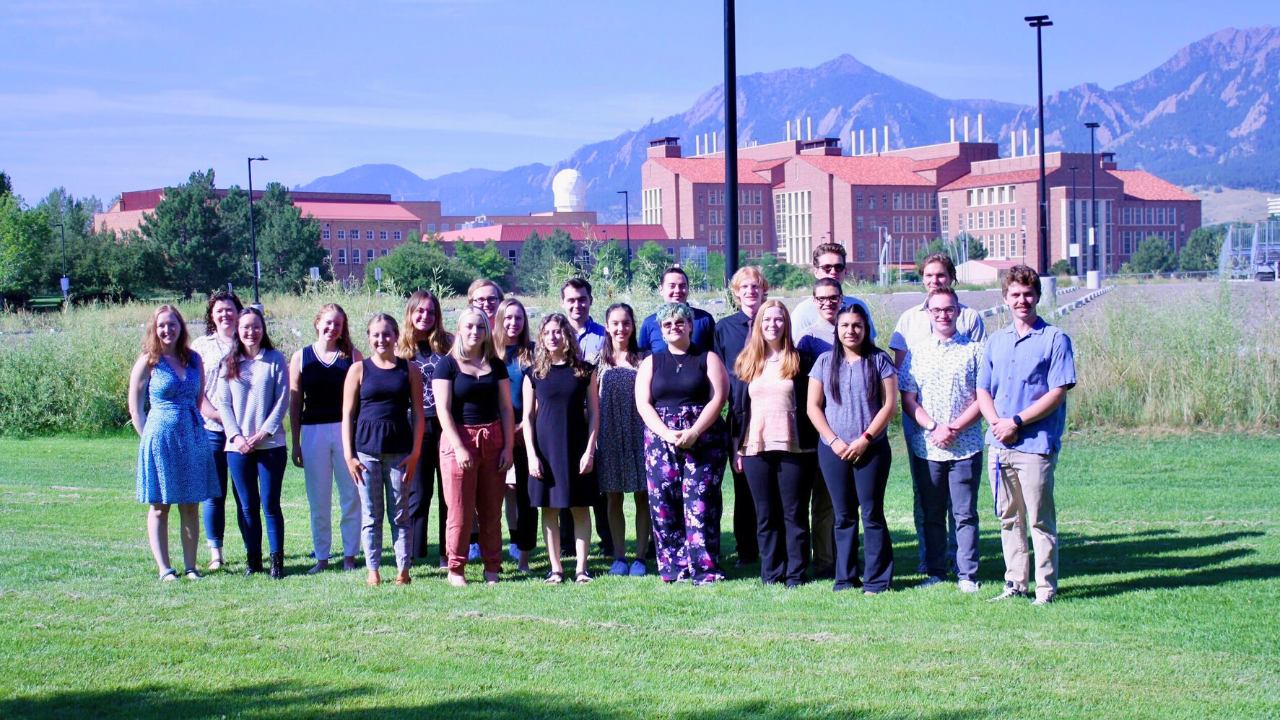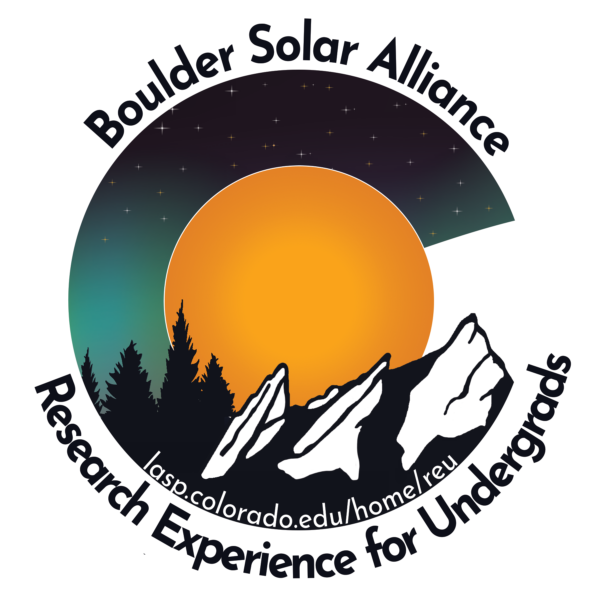
This summer 18 students are participating in the Boulder Solar Alliance Research Experience for Undergraduates (BSA REU) program, which offers students from a wide variety of backgrounds the opportunity to participate in scientific research guided by professional mentors. This program, which began in 2007, is managed by the Laboratory for Atmospheric and Space Physics (LASP) at the University of Colorado Boulder and the National Solar Observatory and involves eight solar-science institutes in the region.
This year, the program began virtually, with students spending the first week participating in an intense solar and space physics summer school to cover the basics of their research projects. The students spent the following weeks conducting research online and participating in professional development sessions, covering topics such as how to apply to graduate school and creating “elevator pitches” for their projects. During the final two weeks, the students are meeting in person in Boulder, where they’re completing their research projects and presenting their results in oral and poster sessions.
The program is funded by the National Science Foundation to involve students from across the country in meaningful ways in ongoing research and to provide them with valuable job skills as well as opportunities to be mentored by professional researchers. “Many of our students have not previously had the chance to conduct research, especially in solar and space physics,” says REU Co-investigator Wendy Carande, who’s also the software engineering team lead at LASP. “It’s an awesome opportunity for students from diverse backgrounds to get a taste of the excitement of scientific research and collaboration and better understand the significance to our society.”

The 2022 REU students are wrapping up their research this week with presentations and poster sessions. They also competed for funding during the program that will give them the opportunity of presenting their work at national conferences. This year’s cohort is conducting research on topics spanning the broad range of solar and space physics, including:
Understanding our Sun as a star
- Student Mackenzie Baird is working with National Solar Observatory scientists to investigate the Sun’s high-degree acoustic mode frequencies during multiple solar cycles to improve our understanding of the connection between the Sun’s interior and its atmosphere.
- Understanding the long-term variability in the Sun’s chromosphere is necessary to improve our knowledge of flares and other solar phenomena. National Solar Observatory student Garrett Zills is investigating the wavelength variability diagnostics in the chromosphere to help gain a better understanding of its magnetic structure.
- While working at the National Solar Observatory, Carter Woodson is utilizing code to synthesize polarized coronal emission spectra. These are difficult to observe but can provide insight into the energy and configuration of the magnetic field from eruptive solar events.
- Kaitlyn Hemauer is working at the National Center for Atmospheric Research’s High Altitude Observatory to investigate the line-of-sight effects that manifest when observing coronal eruptions. This method can be applied to coronal observations from future instruments, such as DKIST Cryo-NIRSP.
Investigating the dynamics and phenomena of our Sun
- Solar features can range from hundreds of thousands of kilometers to ones so small that they test the limits of current solar-observing equipment. Mentored by National Solar Observatory scientists, student Rachael Weir is creating high-resolution solar mosaics to study several small solar structures, including fibrils.
- In preparation for the 2024 total solar eclipse that will pass over much of America, Sarah Davis is working at the Southwest Research Institute to develop training materials to teach Citizen Continental-America Telescope Eclipse (CATE) Experiment volunteers to help them successfully conduct the experiment on eclipse day.
- Using data from the Solar Dynamic Observatory’s Extreme ultraviolet Variability Experiment , LASP student Gabriela Gonzalez is examining solar flare ion emission lines to determine which ions are blue- vs. red-shifted, which may tell them at what height the flare’s magnetic reconnection occurs.
Space Weather
- Connor Streeter is based at the National Solar Observatory, where he’s studying the evolution of solar filaments to help understand what causes them to erupt into coronal mass ejections. Knowing the evolution can ultimately help with future space weather predictions.
- Working at CIRES NOAA this summer, Brooke Kotten is developing corrections to improve calculations of the X-Ray Sensors (XRS) flare locations. This information is essential to help space weather forecasters assess the real-time risks to Earth.
- LASP student Gabriel Moraga is using machine-learning techniques to improve geoelectric field models, which are critical in helping predict and measure how space weather can affect large power grids and other crucial infrastructure.
Developing code and using machine learning to enhance solar research
- While working at the Southwest Research Institute, Bryce Walbridge is developing a new universal polarization-resolving software package for solar coronal and heliospheric observations. This package will be used to process data coming from the upcoming Polarimeter to Unify the Corona and Heliosphere (PUNCH) mission.
- Although the Robinson et al. (1987) empirical model has been widely applied by the space physics community to study auroral electron precipitation, the accuracy of its formulas remains unclear. Reese Van Putten is spending the summer at LASP developing a new conductance model that will allow scientists to systematically asses the model’s accuracy and limitations.
- Machine-learning models are becoming increasingly important for predicting space phenomena. This summer, Max Doering is developing a machine-learning model at LASP to predict high-energy particles in space. The model will help scientists understand the complex physics that take place in Earth’s plasmasphere.
- Hugo Mettes is working with mentors at the National Center for Atmospheric Research’s High Altitude Observatory to modernize data from Skylab, a 1973 NASA mission that collected some of the first data on coronal mass ejections. The code they are developing helps address issues in the data that made it difficult for proper analysis. Their work will produce a new database of images that can be turned into GIFs and animations that can be used for analyzing the evolution and dynamics of these solar events.
Earth’s Magnetosphere
- While at LASP this summer, Mickayla Dever is comparing the values of the magnetic field obtain by interpolation and the values of the direct measurements of the field obtained by the Magnetospheric Multiscale (MMS) mission. This will allow scientists to check the accuracy of the linearity of the magnetic field across different conditions.
- Joann Jones is spending the summer working with LASP scientists to search for killer electrons. These high-energy particles fall off Earth’s magnetic field lines, resulting in precipitation bands in the outer Van Allen radiation belt. She is developing a computer program to automatically recognize precipitation bands and catalog them to help uncover their origins.
Earth and Planetary Atmospheres
- Amelia Lee is working at LASP to look at the height and density of molecular oxygen in Earth’s thermosphere. She’s conducting this research using stellar occultation scans collected from the Solar Stellar Irradiance Comparison Experiment (SOLSTICE) instrument, on the Solar Radiation and Climate Experiment (SORCE) satellite.
- Caroline Emery is working with scientists at LASP to help predict present-day water loss on Mars by examining the brightness of two wavelengths, Lyman Beta and Lyman Alpha, to estimate the hydrogen and oxygen density in the upper Martian atmosphere.
Written by Willow Reed, LASP Communications Specialist



